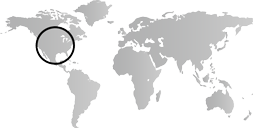Europeans colonize North America in the early seventeenth century, motivated by religious and economic goals. Spain and France, the two Catholic powers in Europe, lead the way, establishing Santa Fe and Québec as their colonial capitals in North America, but Protestant England soon follows along with other European nations such as Sweden and the Dutch Republic. Tens of thousands of English migrants settle along the Atlantic seaboard of North America between 1607 and 1675; they occupy lands previously the territory of Native Americans in three major regions known today as New England, the Middle Atlantic, and the Chesapeake. The English bring distinct traditions across the Atlantic with them, but their experience in the coastal colonies pushes them into new modes of social life and material culture.
By the turn of the eighteenth century, colonial elites emerge in the maturing colonies; plantation owners in the South and the colonial merchants in the North stand out as leading patrons of the arts. New Georgian-style mansions are replete with Rococo furniture forms. Immigrant portraitists seek commissions. The British colonies experience enormous population growth: the mainland colonies have about 400,000 residents in 1720 and nearly 2 million by 1765. A population explosion in Europe brings new waves of white migrants while the continued importation of enslaved Africans increases the number of blacks. An expanding engagement with the British empire brings British manufactured goods, fostering a new identity as Britons. Wealthy Americans travel back seeking the cultural milieu of England and the Continent. However, those attachments and the British desire to raise revenues to finance the operations of the empire generate a crisis in the political relationship between the mother country and the colonists, one that eventually ignites a war for independence.
After the American Revolution, a new federal government and federal culture emerge in the United States of America. An innovative arrangement of sharing power between the electorate, the states, and the national government is created with the drafting and ratification of the U.S. Constitution. Despite the acclaimed selection of George Washington as the first president of the United States, political divisions remain between the northern and southern regions along with differing views of a strong central governmental authority. Political parties soon emerge over these conflicts, but other efforts focus on how to build a new nation. Patrons and artists also devise a distinctive nationalist culture around Neoclassical principles, looking to the ancient republics of Greece and Rome for inspiration for their new republic.


